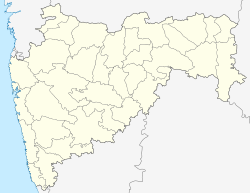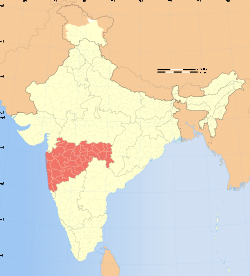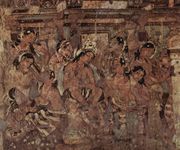Aurangabad, Maharashtra
| Aurangabad औरंगाबाद · اورنگ آباد |
|
| — City of Gates — | |
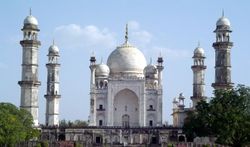 |
|
|
|
|
| Coordinates | |
| Country | |
| Region | Marathwada |
| State | Maharashtra |
| District(s) | Aurangabad |
| Divisional Commissioner of Aurangabad | Bhaskar Munde |
| Mayor | Anita Ghodele |
| Population • Density |
1,167,649 (2009[update]) • 6,051 /km2 (15,672 /sq mi) |
| Official languages | Marathi, Urdu |
|---|---|
| Time zone | IST (UTC+5:30) |
| Area |
200 km2 (77 sq mi) • 513 metres (1,683 ft) |
| Website | www.AurangabadMahapalika.org |
Aurangabad (Marathi: औरंगाबाद, Urdu: اورنگآباد), pronunciation), is a city in the Aurangabad district of Maharashtra, India. Aurangabad (meaning "Built by the Throne") is named after the Mughal Emperor Aurangzeb. The city is a tourist hub, surrounded with many historical monuments, including the Ajanta Caves and Ellora Caves, which are UNESCO World Heritage Sites, as well as Bibi Ka Maqbara. The administrative headquarters of the Aurangabad Division or Marathwada region, Aurangabad is said to be a City of Gates and the strong presence of these can be felt as one drives through the city. Aurangabad is also one of the fastest growing cities in the world.[1]
History
Aurangabad is a city of great historic value as well has natural beauty, which is often referred as srushti in marathi. It was founded in 1610 A.D. by Malik Ambar, the Prime Minister of Murtaza Nizam Shah of Ahmadnagar, on the site of a village called Kharki. He made it his capital and the men of his army raised their dwellings around it. Within a decade, Kharki grew into a populous and imposing city. Malik Ambar cherished strong love and ability for architecture. Aurangabad was Ambar's architectural achievement and creation. Malik Ambar died in 1626.[2] He was succeeded by his son Fateh Khan, who changed the name of Kharki to Fatehnagar. With the capture of Daulatabad by the imperial troops in 1633, the Nizam Shahi dominions, including Fatehnagar, came under the possession of the Moghals. In 1653 when Prince Aurangzeb was appointed the viceroy of the Deccan for the second time, he made Fatehnagar his capital and called it Aurangabad. Aurangabad is sometimes referred to as Khujista Bunyad by the Chroniclers of Aurangzeb's reign.
Bibi Ka Maqbara was built in 1660 by Aurangzeb's son, Azam Shah, as a loving tribute to his mother, Dilras Bano Begam. In 1720, Nizam-ul-Mulk Asif Jah, a distinguished General of Aurangzeb with the intention of founding his own dynasty in the Deccan, arrived at Aurangabad and made it his capital. He paid a visit to Delhi in 1723, but returned in 1724, Nizam Ali Khan Asaf Jah II transferred his capital from Aurangabad to Hyderabad in 1763.[3]
1857 War of Independence
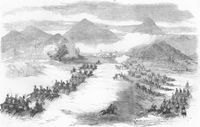
The year 1857 was eventful in the history of Aurangabad with the rest of the country. The British moved the first cavalry from Mominabad (Ambejogai) to Aurangabad, in order to relieve 3rd cavalry which had marched to Malegaon, and was the first regiment to show signs of disaffection. The 2nd Infantry also came under suspicion. The authorities at Hyderabad were kept informed of the course of events by express. Upon this, a column of troops was ordered to march from Pune to Aurangabad. In the meanwhile, the artillery was also showing signs of rebellion, but the rumour of Bombay troops marching towards Aurangabad had a quieting effect. The men of the cavalry also returned to their posts.
The Pune force was under the command of General Woodburn. Upon his arrival, General Woodburn marched straight to the encampment of the 3rd Cavalry, and the disaffected regiment was ordered out to a dismounted parade. It is very nice city. The rissaldar of the first troop was directed to call out the names of the revolutionaries, and commenced by giving the name of the senior jamadar, who ordered his men to load their carbines. By this time the General with his staff and the English officers were mixed up with the disaffected troops, and hence the guns could not be used to put down the latter. In the confusion that followed, some of the troopers broke away, ran to their horses and fled away. The guns were fired upon them and the Hussars were sent in pursuit; but several of them managed to escape. A dafadar of the cavalry, Mir Fida Ali by name, fired a shot at his commanding officer, Captain Abbott. For this act of his, he was tried by a drum-head, court-martial led and hanged. The court-martial continued its sittings, and 24 of these brave men were condemned, of whom 21 were, shot and 3 mercilessly blown away from guns. About two-thirds of the regiment which had remained quiet was marched to Edalabad and recruited to its full strength by men from the other three regiments of the cavalry. Subsequently the third cavalry served throughout the campaign under Sir Hugh Rose.[3]
Historical Aurangabad
Photographs taken by Lala Deen Dayal & others in the 19th century, sourced from the British Library, Views of HH the Nizam's Dominions, Hyderabad, Deccan.
 Zeb-un-Nisa's palace, Aurangabad 1880s |
 Panchakki, Baba Shah Mosafar Dargah 1880s |
 Bibi Ka Maqbara 1880s |
 Street View Aurangabad 1868 |
 Alamgir mosque at Kila-e-Ark 1880s |
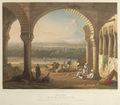 View of Begumpura from Aurangzeb's palace 1830s |
 Kham river & city walls of Aurangabad 1860s |
 Mecca gate Aurangabad 1880s |
Geography and climate
| Aurangabad | ||||||||||||||||||||||||||||||||||||||||||||||||||||||||||||
|---|---|---|---|---|---|---|---|---|---|---|---|---|---|---|---|---|---|---|---|---|---|---|---|---|---|---|---|---|---|---|---|---|---|---|---|---|---|---|---|---|---|---|---|---|---|---|---|---|---|---|---|---|---|---|---|---|---|---|---|---|
| Climate chart () | ||||||||||||||||||||||||||||||||||||||||||||||||||||||||||||
|
||||||||||||||||||||||||||||||||||||||||||||||||||||||||||||
|
||||||||||||||||||||||||||||||||||||||||||||||||||||||||||||
The co-ordinates for Aurangabad are N 19° 53' 47" - E 75° 23' 54". The city is surrounded by hills on all directions.
Climate Classification: Aurangabad features a semiarid climate under the Koppen climate classification.
Temperature: Annual temperatures in Aurangabad range from 9 to 40°C, with the most comfortable time to visit in the winter - October to February. The highest maximum temperature ever recorded was 46°C (114°F) on 25 May 1905. The lowest recorded temperature was 2°C (36°F) on 2 February 1911. In the cold season, the district is sometimes affected by cold waves in association with the eastward passage of western disturbances across north India, when the minimum temperature may drop down to about 2°C to 4°C (35.6°F to 39.2°F).[4]
Rainfall: Most of the rainfall occurs in the monsoon season from June to September. Average annual rainfall is 725 mm.
Demographics
| Population growth | |||
|---|---|---|---|
| Census | Pop. | %± | |
| 1901 | 36,837 |
|
|
| 1911 | 34,902 | -5.3% | |
| 1921 | 36,876 | 5.7% | |
| 1931 | 36,870 | -0.0% | |
| 1941 | 50,924 | 38.1% | |
| 1951 | 66,636 | 30.9% | |
| 1961 | 97,701 | 46.6% | |
| 1971 | 165,253 | 69.1% | |
| 1981 | 301,000 | 82.1% | |
| 1991 | 592,000 | 96.7% | |
| 2001 | 902,179 | 52.4% | |
| Source:Census of India[5][6] | |||
The city with cantonment had a population of 30209 in 1880s of whom Hindus were 59.1 per cent, Muslims were 39.2 percent, Christians were 1.1 percent, Parsis were 0.1 percent, and others were 0.5 percent. In the city proper Brahmins were 7.1 percent and Muslims were 38.5 percent. The city area then was roughly two and half to three and half square miles. In 1971 the city had a population of 1,50,514, (excluding cantonment) the growth during the decade from 1961 to 1971 was 71.86 percent. The growth was highest in the state even higher than Greater Bombay which grew by 43.75 percent.[7]
Marathi and Urdu are the principal languages of the city. According to 1961 census the percentage of residents speaking Marathi were 43.60 percent and residents speaking Urdu were 36.69 percent. Hindi speakers were third with 11.99 percent.[6]
Economy
There is evidence to believe that Aurangabad was developed as a trading hub four centuries ago. It lies on a major trade route that used to connect north-west India's sea and land ports to the Deccan region.
Industry

The city was a major silk and cotton textile production centre. A fine blend of silk with locally grown cotton was developed as Himroo textile. Paithani silk saris are also made in Aurangabad. With the opening of the Hyderabad-Godavari Valley Railways in the year 1900 several ginning factories were started.[8] After 1960, Maharashtra Industrial Development Corporation (MIDC) began acquiring land and setting up industrial estates. Aurangabad is now classic example of efforts of state government towards balanced industrialisation of state.[9]
Many renowned Indian and MNCs have established themselves in the Industrial Estates of Aurangabad:
|
|
|
|
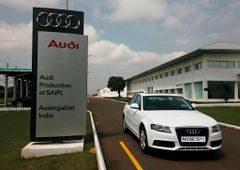
Aurangabad also has 5 star hotels like ITC Welcomgroup's The Rama International, The Ajanta Ambassador, The Taj Residency, The Lemontree (formerly The President Park), Vits (formerly Hotel Vedant)and the Aurangabad Gymkhana
Recently Aurangabad became the third city in Maharashtra (after Pune & Nashik ) to host an auto cluster namely Marathwada Auto Cluster(MAC).[10] Electrical goods major Siemens has setup a plant for manufacturing of superior quality bogies for locomotives, electric multiple units and metro coaches at Shendra MIDC Aurangabad.[11]
Financial services
Modern banking in the district may be said to have begun when the Central Bank of India was established in Hyderabad State on 19 February 1932, at Jalna, and in next year i.e., on 20 December 1933, at Aurangabad. Later on in 1945 the Bank of Hyderabad was established under the Hyderabad State Bank Act of 1350 Fasli.[12]
In the first decade of the twenty-first century, Aurangabad has seen a spurt in financial activities, with almost all public sector and private banks have opened up branches including the State Bank of India, State Bank of Hyderabad, Bank of Maharashtra, Citibank India, Deutsche Bank, ICICI Bank, Bank of India, HDFC Bank, etc. Also Regional Rural Bank viz. Maharashtra Godavari Gramin Bank has its head office in Aurangabad city.
Administration and politics
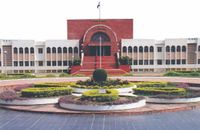
Local administration
Aurangabad Municipal Corporation (AMC) is the local civil body. It is divided into six zones. The Municipal Council was established in 1936, the Municipal Council area was about 54.5 km2. It was elevated to the status of Municipal Corporation from 8 December 1982, and simultaneously including eighteen peripheral villages, making total area under its jurisdiction to 138.5 km2 extended its limits.
The city is divided in 99 electoral wards called as Prabhag, and each ward is represented by a Corporator elected by the people from each ward. There are two Committees, General Body and Standing Committee headed by the Mayor and the Chairman respectively. AMC is responsible for providing basic amenities like drinking water, drainage facility, road,street lights, healthcare facilities, primary schools, etc. AMC collects its revenue from the urban taxes which are imposed on citizens. The administration is headed by the Municipal Commissioner; an I.A.S. Officer, assisted by the other officers of different departments.
State and central administration
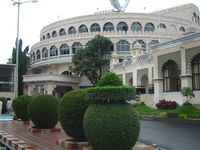
Aurangabad division is one of the six administrative divisions of Maharashtra state in India. Aurangabad divisions almost completely coincides with the Marathwada region of Maharashtra.
Aurangabad contributes one seat to the Lok Sabha - Aurangabad (Lok Sabha constituency). The seat is currently held by Mr. Chandrakant Khaire, MP of the Shiv Sena party. It also holds the seat for the Assembly - Aurangabad West. Mr Rajendra Darda of (Indian National Congress) is the MLA from Aurangabad East constituency and holds the portfolio of Cabinet Minister for Industries, Government of Maharashtra.[13] In latest constituency arrangements made by,[14] Aurangabad will conrtibute one Loksabha seat, and three state assembly seats namely Aurangabad East, Aurangabad West and Aurangabad Central. The latest MLAs being - Aurangabad (East) - Rajendra Darda of Congress(I), Aurangabad (Central) - Pradeep Jaiswal (Independent) and Aurangabad (West) Sanjay Shirsat of Shiv-Sena.[15]
Judiciary
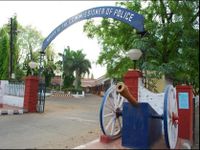
Bombay High Court Aurangabad Bench : The Aurangabad bench of The Bombay High Court was established in 1982. Initially only a few districts of Maharashtra were under the Aurangabad bench. Subsequently in 1988, Ahmednagar and others districts were attached to the bench. The jurisdiction of the Aurangabad Bench is over Aurangabad, Ahmednagar, Dhule, Jalna, Jalgaon, Beed, Parbhani, Latur and Osmanabad. The Aurangabad bench has a strong Bar of more than 700 advocates. The Aurangabad bench has now 15 judges. The present building of bench is situated in a very huge premises. The first phase of centrally located magnificent High Court edifice, having 6,202.18 square metres built up area was opened in the month of June 1995.
Media and communication
- Newspapers: Lokmat is the leading newspaper of the region. Other daily newspapers published in the regional language are Aurangabad Times, Samana, Loksatta, Sakaal, Punyanagri and Sanjvarta.
- Radio: The city has four FM radio stations - All India Radio, Gyaanvani (dedicated to university learning and distance education) and Radio Mirchi 98.3fm, Red FM 93.5, Radio City 91.1 FM, with the private satellite radio station WorldSpace also available.
- Internet: Internet facilities are provided by several suppliers, Now All City is Wi-Max (WI-FI), BSNL is leading internet facilities provider, Media:Broadband Infosystems provides Sify Broadband, METAMAX and Hathway [MCN] providing a broadband service.
Transport
Air
Aurangabad Airport is a domestic airport serving the city and has connecting flights to Delhi, Udaipur, Mumbai, Jaipur as well as Hyderabad. Recently flights were made available to the people traveling to the Hajj pilgrimage.
Rail
Aurangabad (station code:AWB) is a station located on the Kachiguda-Manmad section of the Nanded division of South Central Railway zone of the Indian Railways. Aurangabad has rail connectivity with Mumbai, Delhi, Hyderabad. It is also connected to Nanded, Parli, Nagpur, Nizamabad, Nasik, Pune, Kurnool, Renigunta, Erode, Madurai, Bhopal, Gwalior. But there is still a demand for direct rail connectivity to other major cities of India. The Aurangabad Jan Shatabdi Express is the fastest train connecting it with Mumbai.
Road
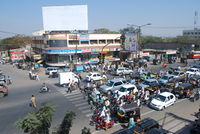
Aurangabad is well connected by roads with various major cities of Maharashtra and other states. National Highway 211 from Dhule to Solapur passes through the city. Aurangabad has road connectivity to Jalna, Pune, Ahmednagar, Nagpur, Beed, Mumbai and the route is currently being upgraded into four lane road of National Highway standard. A new Nagpur–Aurangabad–Mumbai express highway is also being developed.
- Local transort
The Maharashtra State Road Transport Corporation (MSRTC) and numerous other private bus operators provide bus service connecting the city to all parts of the state. Aurangabad Municipal Transport (AMT) is an intra-city bus service for the city, and distant located industrial suburbs.
Education
Aurangabad has transformed into a major education centre in the Deccan due to its proximity with Pune. Aurangabad has schools run by the Aurangabad Municipal Corporation and private schools owned and run by trusts and individuals.[16] Aurangabad has many schools and colleges for higher studies. It has five engineering colleges (including one government engineering college), one government medical college, one polytechnic college. A regional centre of DOEACC is also located here. Some of the renowned institutes in the city are
- Government College of Engineering
- Government Medical College
- Saraswati Bhuvan Prashala
- Mahatma Gandhi Mission, Nanded
- Marathwada Institue of Technolgy
- Peoples Education Society
- Deogiri College
Aurangabad Cantonment
Aurangabad Cantonment is the greenest area of the Aurangabad city. It also has a nine hole golf course, the only such course in Marathwada region. Aurangabad Cantonment was formed in the year 1819 with European Officers to train the Nizam Army. In 1903, a treaty was signed between British and the Nizam, and it was decided to establish a proper Cantonment. Today the Cantonment is spread across 2584 acres with civil population of 19274 as per 2001 census.[17]
Tourist attractions
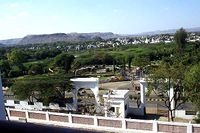
- Bibi Ka Maqbara: Situated about 3 km. from the city is Bibi Ka Maqbara, the burial place of Aurangzeb's wife, Rabia-ud-Durrani. It is an imitation of the Taj at Agra and due to its similar design, it is popularly known as the Mini Taj of the Deccan. The Maqbara stands in the middle of a spacious and formally planned Mughal garden with axial ponds, fountains, water channels, broad pathways and pavilions. Behind the mausoleum is located a small archaeological museum.
- Panchakki (water mill): Is a 17th century water mill situated at a distance of 1 km from the city. An intriguing water mill, the Panchakki is famous for its underground water channel, which traverses more than 8 km. to its source away in the mountains. The channel culminates in a mesmerising 'artificial' waterfall that powers the mill. The beauty of the mosque housed in the inner enclosure is enhanced by a series of 'dancing' water fountains.
- Gates in Aurangabad: One of the things that makes Aurangabad stand out from the several other medieval cities in India are its 52 'gates' each of which have a local history or had individuals linked with them. Not many people are aware of the fact that Aurangabad is also known as the 'City of Gates'.
- Aurangabad Caves: Situated at a distance of 5 km, nestled amidst the hills are 12 Buddhist caves probably dating back to 3 A.D. Of particular interest are the Tantric influences evident in the iconography and architectural designs of the caves. One is also treated to a panoramic view of the city as well as the imposing Maqbara from this point.
- Quila-E-Ark: In 1692, Aurangzeb ordered a palace to be built and named it as the Killa Arrak. The space enclosed by the Killa Arrak or citadel covered nearly the whole ground between the Mecca and Delhi gates of the city. It had four or five gateways and a nagarkhana for the musicians. The walls were battle-mented and loop-holed and had semi-circular towers at the angles, on which guns were once mounted. The inner portion was occupied by recesses similar to those in the city walls. To the right of the entrance was a high terrace extending the whole length of the ground enclosed.
- Kali Masjid, Jumma Masjid: Among the mosques, the Jumma masjid and the Kali masjid built by Malik Ambar, and the Shah Ganj mosque are the most conspicuous. Malik Ambar is said to have built seven mosques which go by the general name of Kali masjid. The Kali masjid is in Juna Bazar area and was erected in 1600 A. D. It is a six-pillared stone-building standing on a high plinth. The Jumma masjid of Malik Ambar is near the Killa Arrak. It has fifty polygonal pillars arranged in five rows, and connected by a system of arches, which divide the building into twenty-seven equal compartments, each covered by a domical vault of simple but elegant design. There are nine pointed arches in front. Of these, five were erected by Malik Ambar in 1612 A. D. and the remaining four were added by Aurangzeb.
- Shahganj Masjid: Occupying the great market square of Aurangabad is the large Shah Ganj mosque, one of the finest edifices of its class to be found in any put of India. It was built in about 1720 A.D. Khafi Khan, the author of Muntakhabu-1-Lubab, referring to Sayyad Husain Khan’s viceroyalty of the Deccan (1714–1719) says "the reservoir at Shah Ganj was begun by Sayyad Husain Ali, and although Aazu-d Daula Iraz Khan enlarged and made higher the buildings and mosques still Sayyad Husain Ali was the originator of that extensive reservoir, which in summer, when water is scarce relieves the sufferings of the inhabitants".
- Chowk Masjid: In 1655 was built the Chauk Masjid by Shayista Khan, the maternal uncle of Aurangzeb. Its front has five pointed arches, and is two arches in depth. These are connected with one another by eight pillars and corresponding pilasters, and support five domes. The central dome, with a metallic spire is lofty, while the others are concealed in the roof. The corners are decorated with minarets.
- Salim Ali Lake & Bird Sanctuary: Salim Ali Sarovar (lake) popularly known as Salim Ali Talab is located near Delhi Gate, opposite Himayat Bagh, Aurangabad. It is located in the northern part of the city. During the Mughal period it was known as Khiziri Talab. It has been renamed after the great ornithologist and naturalist Salim Ali. It also has a bird Sanctuary and a garden maintained by the Aurangabad Municipal Corporation.
Culture and cuisine
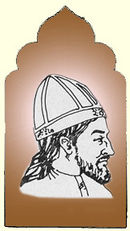
Culture
The culture of Aurangabad city is heavily influenced by Hyderabad. The old city still retains the cultural flavour and charms of Muslim culture of Hyderabad. Its influence is reflected in the language and cuisine of the locals. Although Marathi and Urdu are the principal languages of the city, they are spoken in Dakhni – Hyderabadi Urdu dialect.[18]
Wali Dakhni also known as Wali Aurangabadi (1667–1731 or 1743) was a classical poet of Urdu from Aurangabad. He was the first established poet to have composed in Urdu language. Prominent poets like Shah Hatem, Shah Abro, Mir Taqi Mir, Zauq and Sauda were among his admirers.[19] Other prominent poets from Aurangabad include Siraj Aurangabadi, Azad Bilgrami and Sikandar Ali Wajd.
Cuisine
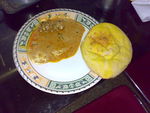
Aurangabadi food is much like Mughlai or Hyderabadi cuisine with its fragrant pulao and Biryani. Meat cooked in fresh spices and herbs is a speciality, as are the delectable sweets. The local cuisine is a blend of Mughlai and Hyderabadi cuisine, with an influence of the spices and herbs of the Marathwada region.[20]
Naan Qalia is a dish that is associated with Aurangabad in India. It is a concoction of mutton and a variety of spices. Naan is the bread made in tandoor (Hot furnace) while Qalia is a mixture of mutton and various spices.
The dish originated in the army camp of Muhammad bin Tughlaq when he shifted his capital from Delhi to Daulatabad in the year 1327. Later the dish was used in the army camps of the Mughals who had their base in and around Daulatabad and Aurangabad in the deccan. Soldiers and camp followers settled in Aurangabad patronised the dish and the tradition continues to this day.
Tahri or Tahari is similar to pulao–Biryani and is very popular in Aurangabad and Marathwada. Tahri is prepared by adding the meat to the rice, as opposed to traditional Biryani where the rice is added to the meat.[21]
Aurangabad / Marathwada / Dakhni cuisine is a blend of the Puneri and the Hyderabadi cuisine (which beautifully blends the use of typical South Indian ingredients such as curry leaves, tamarind and coconut into their celebrated culinary practices).[22] Distinctively different from the Hyderabadi cuisine , the Deccani cuisine (Marathwada, North Karnataka and Telangana) is a simple yet sumptuously wholesome affair. The stress is on the powdered masalas and their right proportions while cooking, unlike the Mughlai items where emphasis is on opulent garnishing and seasoning. While Mughlai is mostly prepared by low-simmer in dum-style, Deccani food is not as time consuming and spicy as its royal counterpart.[23]
The availability of staple, easily used ingredients and some derivatives such as the Vadis (dried rice/lentil nuggets), vegetables of the season – Vangi (brinjals) appear on most menus while the other lentils from the region make their presence felt in the Jhunkas and Pitlas (raw tomato curry made thick with besan). The use of groundnut with garlic, chillies and kopra are seen in the creation of the Chutney, 'thecha' and pastes/gravy (with the onion as the main ingredient). The mutton and fowl are celebrated for their tenderness and taste (locally, the Gavran Chicken though fibrous as compared to the broiler is a hot favourite for its robust taste). The accompanying bread is of Jwarichi bhaakri, or Bajrichi Bhakari, Poli and variations such as 'Dhapate' are well known, the Thalipeeth, which is made from a combination of various grains and partaken with butter.[22]
Local Arts
- Paithani Textiles: The Paithani sarees from Paithan are considered to be priced possession by one and all. One can get an opportunity to witness this age old art of weaving Paithani sarees. The yarn used is of pure silk and the zari or gold threads drawn from pure gold.
Mashru and Himroo
Aurangabad is famous for Mashru and Himroo fabrics made of cotton and silk with the luster of satin. Himru is an age-old weaving craft, and was originally known as kum khuab.
- Himroo: The fabric is said to have originated in Persia, though not conclusively proved, Himroo is associated with the times of Mohammad Tughlaq who ruled in the 14th century. When Mohammad Tughlaq shifted his capital from Delhi to Daulatabad many weavers came and settled here. During the exodus the weavers instead of returning to Delhi stayed back here. During the reign of Malik Ambar, the city's fame attracted many people from far and wide. During the Mughal rule under Aurangzeb's governorship, Auarangabad the capital and the weavers became more prosperous. The only industry in Aurangabad allured hundreds of craftsman. Members of the royal family and an elite few used the famous Aurangabad Himroo. Himroo weaving is very characteristic and distinctive. Fabrics and shawls from Aurangabad are much in demand for their unique style and design.[24]
- Bidriware : A unique form of gold and silver inlays on copper is preserved here from ancient Persian traditions that have been sustained in the Deccan. This ancient art still finds expression in the modern items like cufflinks, nameplates and more. Typical bidri items include plates, bowls, vases, ashtrays, trinket boxes, huqqa bases and jewellery.
- Kaghzipura : A place situated near Daulatabad made first handmade paper in India after the technology was brought here by Mongol invaders. Interestingly this paper has been used to print the Quran.[24]
See also
- Tourist attractions in Aurangabad
- Sufi Saints of Aurangabad
- Aurangabad Naher water system
- Neighborhoods of Aurangabad City
- Aurangabad CIDCO
- Dr. Babasaheb Ambedkar Marathwada University
Gallery
|
Kailasha Temple in Ellora Caves |
 Bibi Ka Maqbara |
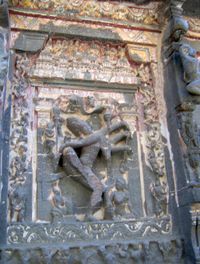 Kailash temple in Ellora Caves |
|
|
Daulatabad (deogiri) fort |
 Panchakki, Old Flour mill running with the force of water and The Fountain. |
 Siddhartha Garden |
|
 Painting from the Ajanta Caves in Aurangabad, Maharashtra, sixth century. |
 Dnyneshwar Udyan, Paithan |
 Hutatma Stumbh |
Geographical Location
 |
Jalgaon |  |
||
| Nashik | Jalna | |||
| Ahmednagar Beed |
References
- ↑ 11 Indian cities among worlds fastest growing.
- ↑ Qureshi Dulari, "Tourism Potential in Aurangabad," p.6
- ↑ 3.0 3.1 Govt of Maharashtra - Aurangabad Gazetteer
- ↑ Maharashtra government web site
- ↑ "Mahapopulation" (in Marathi) (PDF). Census of India. www.maharashtra.gov.in. http://www.maharashtra.gov.in/english/ecoSurvey/ataglanc.pdf. Retrieved 2008-06-04.
- ↑ 6.0 6.1 [Govt of Maharashtra Aurangabad Gazetteer. Section - The People (population)]
- ↑ [The Outlook Tower:Essays On Urbanisation In Memory Of Patrick Geddes - Page 340].
- ↑ "Hyderabad" by Mirza Mehdy Khan, Imperial Gazetteer of India, Government Printing Press, Calcutta, 1909.
- ↑ TOI. "History revisited at Aurangabad". http://economictimes.indiatimes.com/features/the-sunday-et/consumer-life/History-revisited-at-Aurangabad-the-city-of-gates/articleshow/4390611.cms. Retrieved 2010-01-20.
- ↑ Indian Expresses (Finally, Aurangabad gets its auto cluster).
- ↑ Siemens bogie facility at Aurangabad commences operations.
- ↑ Maharashtra government web site Banking and Finance Aurangabad
- ↑ Ministers in Government of Maharashtra.
- ↑ Election Commission of India
- ↑ Map of Aurangabad Loksabha and Assembly seats
- ↑ "Educational Institutes, Colleges and Universtities in Inda". Education 4 India. http://institutions.education4india.com/category/cities-in-india/maharashtra/aurangabad/. Retrieved 2009-07-22.
- ↑ Aurangabad Cantonment website
- ↑ DAKHNI The Language in which the Composite Culture of India was Born by T. Vijayendra.
- ↑ (Wali Dakhni) The Language in which the Composite Culture of India was Born by T. Vijayendra.
- ↑ The cuisine of Auguranbad
- ↑ Types of Biryani - Adibah.co.uk
- ↑ 22.0 22.1 Upper Crust
- ↑ The Hindu - Plateau palate
- ↑ 24.0 24.1 Qureshi, Dulari (1999). Tourism Potential in Aurangabad. Delhi: Bhartiya Kala Prakashan. p. 65. ISBN 8186050442.
External links
|
|||||||||||||||||||||||||||||||
|
|||||||||||||||||||||||
|
||||||||
